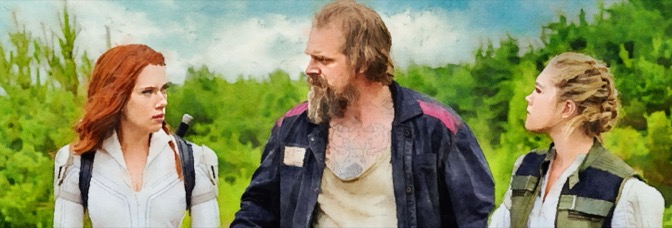Black Widow gets a lot better after the first act. Mostly because the prologue—set in 1995 Ohio where tween-who-will-be-Scarlet-Johansson Ever Anderson lives with her All-American family (little sister Violet McGraw, mom Rachel Weisz, dad David Harbour)—is almost classy enough. With better music and a more patient, less blandly jingoistic look at Americana, it’d be potentially great; Widow’s got a handful of scenes where the actors’ performances break its commercial bounds and its potential all of a sudden seems boundless, but the prologue is about the only time the filmmaking’s there. Even with the weak score and anemic filmmaking—though, it takes place in Ohio so it is kind of appropriate it’s flavorless. And it answers the question of Johansson never having a Russian accent even though the character’s Russian.
Except then it turns out she’s not about to be bitten by a radioactive black widow and they’re actually Russian sleeper agents and they’ve got to get out of town. It ends up being a really effective sequence thanks to the acting, Anderson in particular, and the action set piece out of a James Bond movie.
Almost all of Widow’s action set pieces seem like they’re out of a James Bond movie. There’s even a scene where we find out Johansson—grown-up—loves James Bond movies. Loves Moonraker. So, like, laughably bad taste but the reference also sets the film’s targets appropriately. I’ve actually never seen Moonraker; I don’t know if Widow ends up homaging it with any of the sequences. The movie’s got a very Bond villain in Ray Winstone, but only on the surface. Winstone’s repugnant villain isn’t flashy at all. He’s just an evil son of a bitch. At the beginning of his villain monologue I wondered why—well, I wondered why they didn’t get a single Russian actor for the four new Russian parts–but I also wondered why he wasn’t flashy. No scenery chewing. Ray Winstone can eat a couch, but not here. Because he’s just a repugnant son of a bitch. Take out the Bond villain hideout and he’s the realest Marvel villain maybe ever.
After the too long opening credits (flashbacks to Anderson’s assassin training intercut with her happy Ohio life), it’s post Captain America 3 and William Hurt is hunting down Johansson. But since it’s the first act, she gets away for now and runs off to… well, somewhere. But then gets attacked by a costumed supervillain called “The Taskmaster” who can duplicate any fighting style he sees, which is comics accurate. Why they decided to make him look like an extreme sports version of early eighties Batman villain “The Sportsman” (not Sportsmaster, Sportsman)… well, I assume budget. Since most of the characters aren’t actually superheroes, but they all have costumes and then they have multiple ones because action figures, it’s often Johansson fighting a bad guy who looks like a mid-eighties Darth Vader rip-off.
Like almost out of the Dolph Lundgren Masters of the Universe movie. Throw in the uninspired (being complimentary there) fight choreography and cinematographer Gabriel Beristain shooting everything through a yellow pee filter, it seems like Widow’s going to be a slog.
But then Florence Pugh shows up—playing little sister grown-up—and it starts getting better. Pugh and Johansson aren’t great together from the start. Pugh’s great. Johansson’s outacted—though the script’s particularly not great for that portion of the film. Once Harbour and Weisz show up in the present action, however, everything starts to balance out nicely. Minus some joyless flashback reveals and more disappointing fight scenes.
Best performance is Pugh or Harbour, then Weisz. Johansson ends up doing pretty well, even though the movie—her single solo outing without any of the boy Avengers comes eleven years after she first appeared in the part and is, due to big developments in the boy movies, a flashback story. Though there’s room for more because the epilogue is nonsensical and entirely played for a fun Bond-esque moment.
Shortland’s direction is middling. She’s better with the actors than the action for sure, but even then it takes until Harbour shows up to get the energy right. She does all right with the tension, however, which is important since Johansson not really be in danger is part of the film’s conceit. After all, she’s fine for the movies you’ve presumably already seen. But it works even in the prologue. Shortland’s good at finding the humanity in the characters. And the actors run with that humanity admirably.
There were a couple surprising omissions—not including the big, intentional plot hole—and it seems like they could definitely gin up a sequel. And even it were as contrived as this outing, it’d be welcome one. Johansson and company (emphasis on the company) work really well together.

Leave a Reply